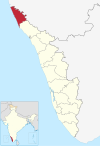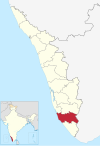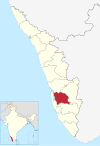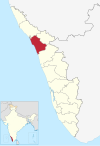| Districts of Kerala | |
|---|---|
 Districts of Kerala Districts of Kerala | |
| Category | Districts |
| Location | Kerala |
| Number | 14 districts |
| Populations | Wayanad – 846,637 (lowest); Malappuram – 4,494,998 (highest) |
| Areas | Alappuzha – 1,415 km (546 sq mi) (smallest); Idukki – 4,612 km (1,781 sq mi) (largest) |
| Government | |
| Subdivisions | |
The Indian state of Kerala is divided into 14 districts. Districts are the major administrative units of a state which are further sub-divided into revenue divisions and taluks.
Idukki district is the largest district in Kerala with a total land area of 4,61,223.14 hectares.
When the independent India merged smaller states together, Travancore and Cochin states were integrated to form Travancore-Cochin state on 1 July 1949. However, North Malabar and South Malabar remained under the Madras state. The States Reorganisation Act of 1 November 1956 elevated Kerala to statehood through the unification of Malayalam-speaking territories in the southwestern Malabar Coast of India.
The state comprises three parts – the Northern Kerala districts of Kasaragod, Kannur, Wayanad, Kozhikode, Malappuram; the Central Kerala districts of Palakkad, Thrissur, Ernakulam, Idukki; and the Southern Kerala districts of Kottayam, Alappuzha, Pathanamthitta, Kollam, and Thiruvananthapuram. Such a regional division occurred being part of historical regions of Cochin, North Malabar, South Malabar, and Travancore. The North Malabar region, which is culturally distinct from the rest of Kerala, entirely lies in the districts of Northern Kerala. North Malabar region includes Kasargod, Kannur, Wayanad, and the northern region of Kozhikode district, south Malabar region includes south-central part of Kozhikode district, Malappuram, parts except Chittoor taluk of Palakkad district, Kunnamkulam and Chavakkad region of Thrissur district. The regions of South Malabar and Kingdom of Cochin, both of which share many historical, geographical, and cultural similarities, together constitute the districts of Central Kerala. The Travancore region is incorporated in the districts of South Kerala. The Travancore region was again divided into three zones as Northern Travancore (Hill Range) (Idukki District, Kottayam district and eastern portion of Ernakulam district), Central Travancore (Central Range) (Kollam district, Pathanamthitta and Alappuzha district) and Southern Travancore (Southern Range) (Thiruvananthapuram).
The districts in Kerala are often named after the largest town or city in the district. Some of the districts were renamed in 1990 from the anglicised names to their local names. The 14 districts are further divided into 27 revenue divisions, 77 taluks, and 1664 revenue villages.
For local governance, Kerala has 6 Municipal Corporations and 87 Municipalities overseeing urban areas. Additionally, there are 941 Gram Panchayats, 152 Block Panchayats, and 14 District Panchayats responsible for rural governance.
Administrative structure

Kerala State has been divided into 14 districts, 27 revenue divisions, 78 taluks, 152 community development blocks, and 1664 revenue villages.
Revenue administration
A district is administered by a District Collector, who is an officer of the Indian Administrative Service (IAS) of Kerala cadre, and is appointed by the State Government of Kerala. The headquarters of the district administration is known as the Collectorate. The District Collector serves as the head of revenue administration in the district and also functions as the District Magistrate responsible for maintaining law and order within the district. The Collector serves as both the agent of the state Government and also as the representative of the people in the district. District administration is performed by the various Departments of the State Government, each of which has its own office at the district level. The District Officers of the various Departments in the district render technical advice to the collector in the discharge of his duties. The district collector is assisted by an additional district magistrate and deputy collectors.
The districts are divided into revenue divisions which comprises several taluks under its jurisdiction. Taluks comprises several revenue villages. A revenue division is headed by a Revenue Divisional Officer/Sub Collector, and taluk is headed by a Tehsildar. The Tahsildar is assisted in each revenue village by village officers and village assistants. Village offices functions as the grassroot of the revenue administration.
Local governance
For the purpose of local governance, there are local-self government institutions, which includes 941 Gram panchayats, 152 block panchayats, 14 district panchayats, 6 corporations and 87 municipalities.
The panchayati raj institutions (gram panchayats, block panchayats, district panchayats) look after the governance of the rural areas in the district. These panchayats are governed by elected councils, headed by presidents and vice presidents respectively.
The urban local bodies (municipalities and municipal corporations) look after the governance of the urban areas in the district. These urban local bodies are governed by elected municipal councils, headed by mayor/chairperson and deputy mayor/vice chairperson respectively. A municipality, which consists of urban areas, is administered by a municipal council headed by a Municipal Chairperson. In cities, a municipal corporation, administered by a corporation council headed by a mayor, oversees the municipal affairs.
The other administrative subdivision is "blocks", which is co-terminus with the block panchayats area. Th CD blocks are established for the purpose of rural development, aligning with the boundaries of the block panchayat. Each CD Block encompasses several gram panchayats within its limit. A block is administered by a Block Development Officer (BDO), appointed by the government, who also functions as the ex-officio secretary of the Block Panchayat.
A taluk consists of urban units such as statutory towns and census towns and rural units called gram panchayats (for revenue purposes). The Local Self-Governments Department (LSGD), Government of Kerala, coordinates and supervises the administrative affairs of these local bodies and has district-level offices.
Police
Main article: Kerala PoliceThere are 20 police districts in total, and among these, 8 police districts are coterminous with the respective revenue districts, while the remaining 12 police districts are constituted by bifurcating the revenue district into "city" and "rural" areas. Each police district is headed by a "District Police Chief" (DPC), an IPS officer typically holding the rank of Superintendent of Police (SP) or above. The District Police Chief is responsible for maintaining law and order, conducting criminal investigations, and overseeing police administration in the district.
These districts are further divided into police sub-divisions. A subdivision comprises several police stations under its jurisdiction, each headed by an Assistant Superintendent of Police or Deputy Superintendent of Police (DySP) designated as the sub-divisional police officer (SDPO). The police station is the basic unit of police administration at the district level, each headed by an Inspector of Police, or in the case of rural areas, by a Sub-Inspector of Police designated as the Station House Officer (SHO).
Judiciary
The Kerala High Court has the jurisdiction of the state of Kerala. Each of the districts has a District & Sessions Court.
Other
Each state government department has a district office at the district level, headed by district-level officials, such as the District Medical Officer for the health department, District Fire Officer for the Fire and Rescue Department, Divisional Forest Officer for the Forest Department, etc. Each department's district-level offices oversee their respective areas of administration.
Districts in KeralaHistory
At the time of formation, Kerala had only five districts: Malabar, Thrissur, Kottayam, Kollam, and Thiruvananthapuram.
On 1 January 1957, the Malabar district was trifurcated to form new districts of Kannur, Kozhikode, and Palakkad, bringing the total to seven districts.
Alappuzha district was carved out of erstwhile Kottayam and Kollam districts on 17 August 1957, to form the 8th district.
Ernakulam district was formed on 1 April 1958 as the 9th district, carved out of parts of erstwhile Thrissur and Kottayam districts.
Malappuram district was formed on 16 June 1969 as the 10th district, with Ernad and Tirur taluks of the erstwhile Kozhikode district and Perinthalmanna and Ponnani taluks of Palakkad district.
Idukki district was formed on 26 January 1972 as the 11th district, with Devikulam, Udumbanchola and Peermedu taluks of the erstwhile Kottayam district and Thodupuzha taluk of the erstwhile Ernakulam district.
Wayanad district was formed on 1 November 1980 as the 12th district in Kerala by carving out areas from Kozhikode and Kannur districts.
Pathanamthitta district was formed on 1 November 1982 as the 13th district by carving out the entire Pathanamthitta taluk and nine villages of Kunnathur taluk from Kollam district, entire Thiruvalla taluk and part of Chengannur and Mavelikkara taluks from Alapphuzha district and parts of Idukki district.
Kasaragod district was formed on 24 May 1984 as the 14th district by carving out a major portion of the erstwhile Kannur district.
Characteristics
Idukki district is the largest district in Kerala by area. Alappuzha district is noted for its small area, while Malappuram district stands out as the most populous in Kerala. Wayanad, Idukki, and Kasargod are the least populated districts in the state. Ernakulam district stands out as the most urbanized in Kerala, housing a municipal corporation and 11 municipalities, with 68.07% of its population residing in urban areas. Thiruvananthapuram has the highest population density at 1509 persons per sq.km, followed closely by Alappuzha and Kozhikode districts.
Alphabetical listing
| Code | District | Headquarters | Established | Population (2018) | Area | Subdivisions | Map |
|---|---|---|---|---|---|---|---|
| ALA | Alappuzha | Alappuzha | 17 Aug 1957 | 2,146,033 | 1,415 km (546 sq mi) | 
| |
| ERN | Ernakulam | Kakkanad | 1 Apr 1958 | 3,427,659 | 2,924 km (1,129 sq mi) | 
| |
| IDU | Idukki | Painavu | 26 Jan 1972 | 1,093,156 | 4,612 km (1,781 sq mi) | 
| |
| KAN | Kannur | Kannur | 1 Jan 1957 | 2,615,266 | 2,966 km (1,145 sq mi) | 
| |
| KAS | Kasaragod | Kasaragod | 24 May 1984 | 1,390,894 | 1,989 km (768 sq mi) | 
| |
| KOL | Kollam | Kollam | 1 Nov 1956 ( 1 July 1949) |
2,659,431 | 2,483 km (959 sq mi) | 
| |
| KOT | Kottayam | Kottayam | 1 Nov 1956 (1 July 1949 ) |
1,983,573 | 2,206 km (852 sq mi) | 
| |
| KOZ | Kozhikode | Kozhikode | 1 Jan 1957 | 3,249,761 | 2,345 km (905 sq mi) | 
| |
| MAL | Malappuram | Malappuram | 16 Jun 1969 | 4,494,998 | 3,554 km (1,372 sq mi) | 
| |
| PAL | Palakkad | Palakkad | 1 Jan 1957 | 2,952,254 | 4,482 km (1,731 sq mi) | 
| |
| PAT | Pathanamthitta | Pathanamthitta | 1 Nov 1982 | 1,172,212 | 2,652 km (1,024 sq mi) | 
| |
| THI | Thiruvananthapuram | Thiruvananthapuram | 1 Nov 1956 (1 July 1949) |
3,355,148 | 2,189 km (845 sq mi) | 
| |
| THR | Thrissur | Thrissur | 1 Nov 1956 (1 Jul 1949) |
3,243,170 | 3,027 km (1,169 sq mi) | 
| |
| WAY | Wayanad | Kalpetta | 1 Nov 1980 | 846,637 | 2,130 km (820 sq mi) | 
| |
| Total | 14 | 14 | 14 | 34,630,192 | 38,852 km (15,001 sq mi) | 78 |
See also
- Kerala
- Government of Kerala
- Revenue Department (Kerala)
- List of revenue divisions of Kerala
- List of taluks of Kerala
References
- "Revenue administration (Department of Revenue, Government of Kerala)".
- "Idukki reclaims top spot as Kerala's largest district". English.Mathrubhumi. 11 September 2023. Retrieved 6 July 2024.
- "Central Kerala". Kerala Tourism. Retrieved 12 January 2024.
- ^ William Logan (1887). Malabar Manual (Volume-I). Madras Government Press.
- C. Achutha Menon (1911). The Cochin State Manual. Cochin Government Press.
- V. Nagam Aiya (1906). The Travancore State Manual. Travancore Government Press.
- J.B.C. (September 1953). "State of Travancore-Cochin. The Travancore-Cochin Legislative Assembly Manual. (Ernakulam: Government Press. 1952. Pp. xii, 132.)". American Political Science Review. 47 (3): 903–903. doi:10.1017/s0003055400301198. ISSN 0003-0554.
- Stateitcell. "Structure". www.clr.kerala.gov.in. Retrieved 11 May 2024.
- Bureau, The Hindu (11 September 2023). "Idukki once again becomes the biggest district in State". The Hindu. ISSN 0971-751X. Retrieved 26 March 2024.
{{cite news}}:|last=has generic name (help) - "Urbanization in Kerala".
- "Economic review, 2017 State Planning Board, Government of Kerala".
- "NIC Policy on format of e-mail Address: Appendix (2): Districts Abbreviations as per ISO 3166–2" (PDF). Ministry Of Communications and Information Technology, Government of India. 10 August 2004. pp. 5–10. Archived from the original (PDF) on 11 September 2008. Retrieved 24 November 2008.
- "Districts : Kerala". Government of India portal. Retrieved 11 March 2009.
- Here 'Established' means the year of establishment as a district of Kerala. If the district was formed earlier than the formation of the state of Kerala, 1 Nov 1956 will be considered as the day of establishment of the district.
- Annual Vital Statistics Report - 2018 (PDF). Thiruvananthapuram: Department of Economics and Statistics, Government of Kerala. 2020. p. 55.
- "Part I: state" (PDF). Government of India Census portal. Retrieved 8 December 2015.
- ^ "Alappuzha : History". alappuzha.nic.in. Archived from the original on 10 April 2009. Retrieved 11 March 2009.
- "History of Ernakulam". ernakulam.nic.in ( Ministry of Communication & Information Technology, Govt. of India). Archived from the original on 15 November 2007. Retrieved 11 March 2009.
- "Taluks — Ernakulam District". ernakulam.nic.in. Archived from the original on 27 February 2009. Retrieved 11 March 2009.
- "IDUKKI : History". idukki.nic.in ( Ministry of Communication & Information Technology, Govt. of India). Retrieved 11 March 2009.
- as per Government notification No 54131/C2/71/RD dated 24 January 1972, Government of Kerala
- ^ "Kannur district : Administration". knr.kerala.gov.in ( Govt. of Kerala). Archived from the original on 21 April 2009. Retrieved 11 March 2009.
- "District came into existence..." kasargod.nic.in. Archived from the original on 10 April 2009. Retrieved 11 March 2009.
- As per GO.(MS)No.520/84/RD dated 19.05.1984, Government of Kerala
- "Kasaragod District > taluks". kasargod.nic.in. Retrieved 11 March 2009.
- "Short History of Kollam". kollam.nic.in. Archived from the original on 18 May 2011. Retrieved 11 March 2009.
- ^ Note: This date means the day when the district was initially formed, even before the formation of the state of Kerala. Hence 1 Nov 1956 will be considered as the day of formation of district in the state of Kerala
- Paravur, Kollam
- "Taluks and Villages". Kollam.nic.in. Archived from the original on 10 February 2007. Retrieved 11 March 2009.
- "District Handbooks of Kerala KOTTAYAM" (PDF). kerala.gov.in. Archived from the original (PDF) on 19 March 2009. Retrieved 11 March 2009.
- "KOTTAYAM : Short History". Kerala.gov.in. Retrieved 12 March 2009.
- "Kozhikode: History". kozhikode.nic.in. Archived from the original on 2 April 2007. Retrieved 12 March 2009.
- "Kozhikode: Administration". kozhikode.nic.in. Archived from the original on 7 February 2009. Retrieved 12 March 2009.
- ^ "Malappuram: HISTORY". malappuram.nic.in. Retrieved 12 March 2009.
- "Welcome to Palghat". palghat.net. Retrieved 12 March 2009.
- "BASIC STATISTICS of PALAKKAD". palakkad.nic.in. Archived from the original on 10 April 2009. Retrieved 12 March 2009.
- https://www.mathrubhumi.com › news അട്ടപ്പാടി ട്രൈബൽ താലൂക്ക് ... - Mathrubhumi
- "Pathanamthitta : History". pathanamthitta.nic.in. Archived from the original on 10 April 2009. Retrieved 12 March 2009.
- As per GO (MS) No.1026/82/(RD) dated 29.10.1982, Government of Kerala
- "Pathanamthitta : Administration". pathanamthitta.nic.in. Archived from the original on 10 April 2009. Retrieved 12 March 2009.
- "THIRUVANANTHAPURAM". Archived from the original on 7 February 2009. Retrieved 12 March 2009.
- ^ "Thrissur At A Glance". thrissur.nic.in. Retrieved 12 March 2009.
- ^ "Wayanad :profile". wayanad.nic.in. Retrieved 12 March 2009.
Further reading
- Chandran, VP (2018). Mathrubhumi Yearbook Plus - 2019 (Malayalam Edition). Kozhikode: P. V. Chandran, Managing Editor, Mathrubhumi Printing & Publishing Company Limited, Kozhikode.
External links
| Districts of Kerala | |
|---|---|
| Districts | |